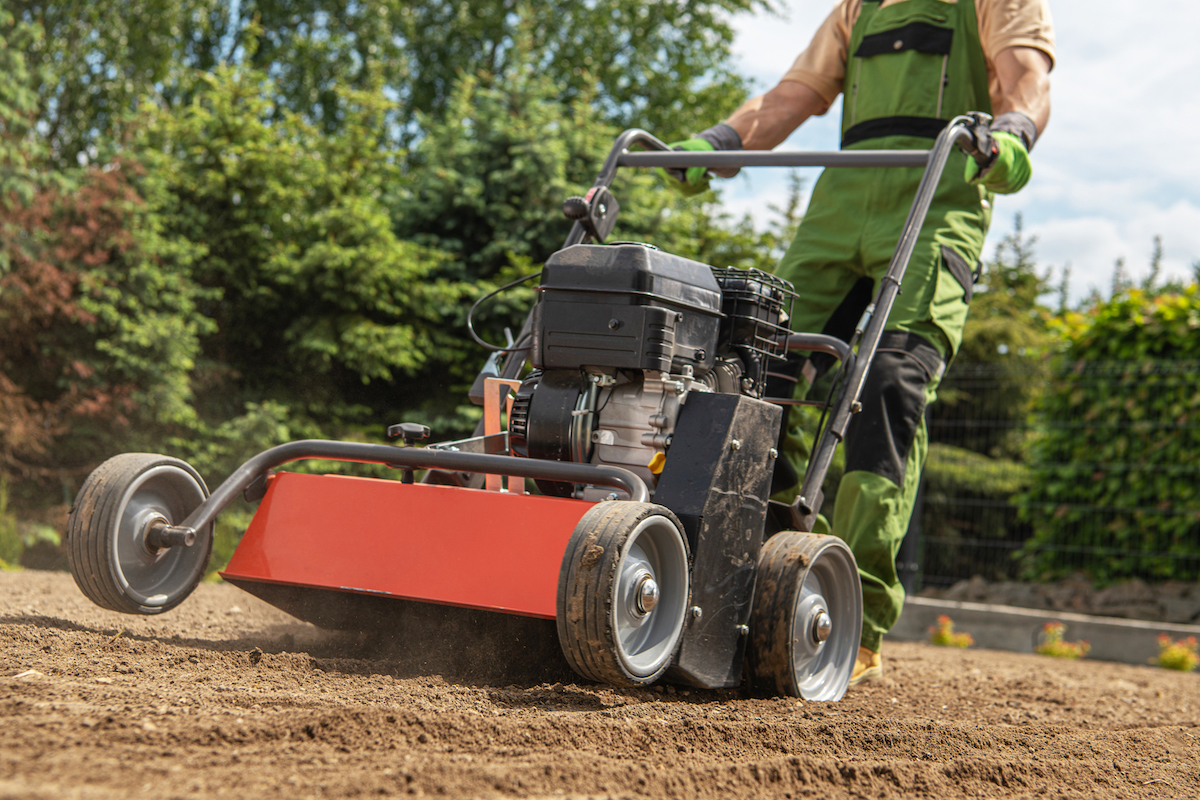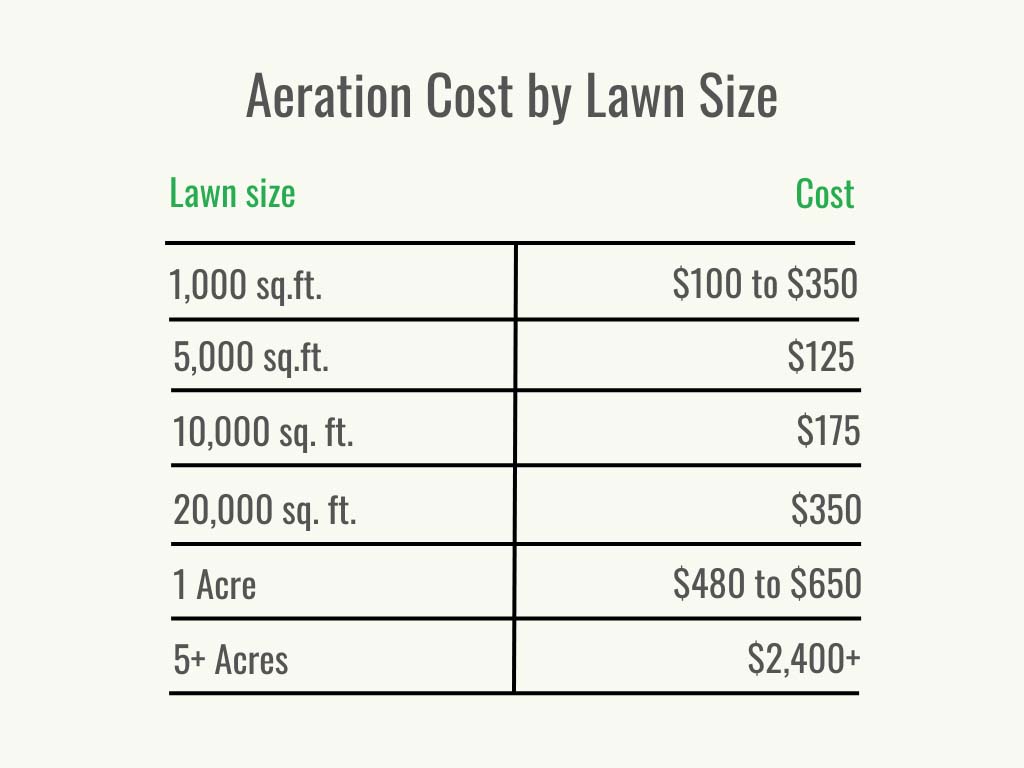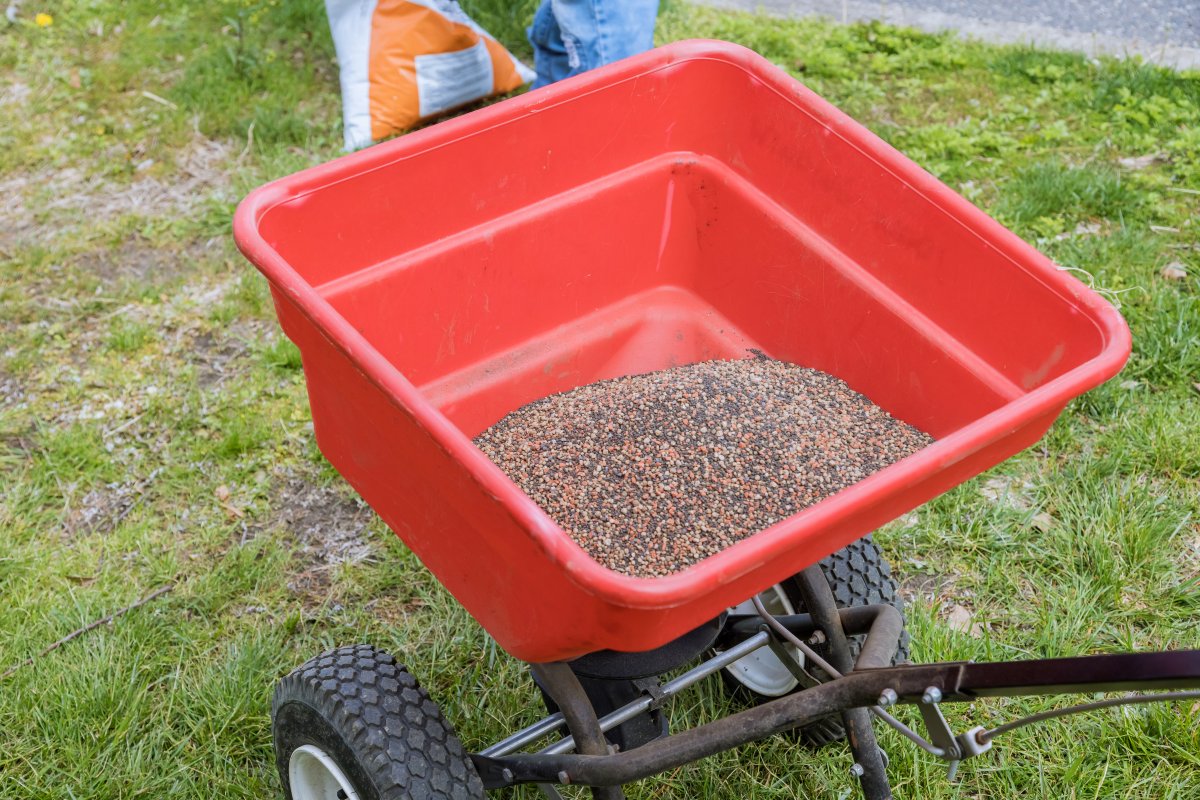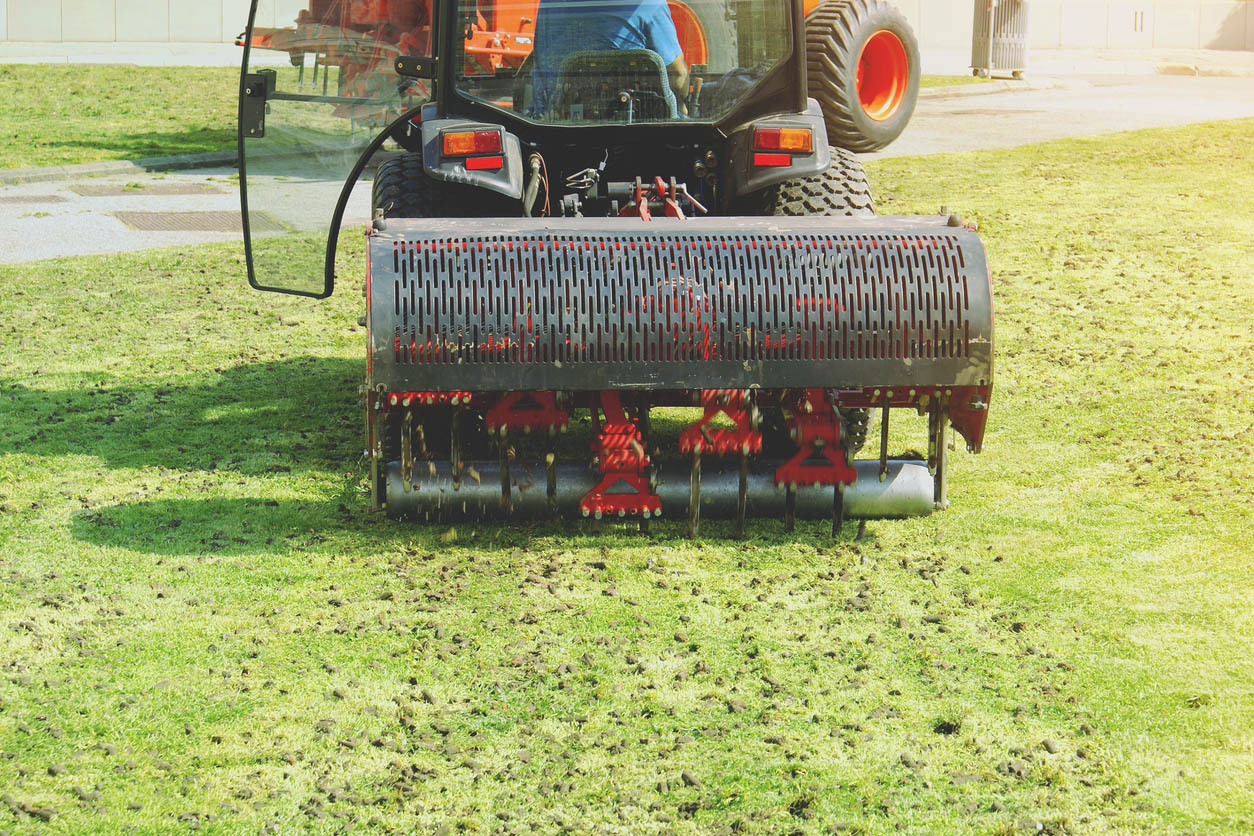

We may earn revenue from the products available on this page and participate in affiliate programs. Learn More ›
Aerating a lawn reduces soil compaction to improve the health of the grass by allowing more oxygen and nutrients to reach the roots. For most lawns, an annual aeration is sufficient. The cost is small compared to other lawn improvement costs, such as installing a sprinkler system or removing a tree, and aerating is one of the best ways to improve a lawn’s condition.
While many factors influence lawn aeration prices, including lawn size, location, and other community factors, you might pay as little as $45 to aerate a small yard, while a large lawn could cost $400 or more to aerate. In most cases, a rep from the lawn company will want to take a look at the property before quoting a price, but the following general guidelines might be helpful.
Aeration Cost by Lawn Size
In many cases, the size of the lawn determines aeration cost. Lawn companies often calculate their square-foot charges in increments, and the larger the yard, in general, the lower the square-foot cost of aerating. For example, while there’s a particular price range to aerate a lawn under 1,000 square feet, that per-square-foot cost may decrease for a yard of 5,000 square feet.
After that, the price may be charged as a flat rate for yards of 10,000 square feet or more. When it comes to massive yards—measured in acres—the overall cost will usually be quite a bit lower per square foot; expect to pay a few hundred dollars per acre for aeration.

Other Factors That Affect Lawn Aeration Cost
Lawn aeration service costs can vary widely based on a number of other considerations beyond the size of the yard. In the hunt for low-cost solutions to lawn care needs, take into account the following factors that will likely affect the final cost.
Aeration Type
Lawn companies typically use one of three aeration methods, and the preferred method for each lawn will impact the price quoted. The type of aeration that arguably offers the most comprehensive benefits, core aeration, costs the most, while spike and liquid aeration are less expensive.
| Aeration Method | Average Cost for a 10,000-square-foot Lawn |
| Core | $200 |
| Spike | $85 |
| Liquid | $75 |
Core Aeration
The equipment required to dig and remove plugs from the existing lawn is typically more expensive than either spike aeration equipment or lawn-spraying equipment, so the end cost is higher. This is reflected in the average 12 to 20 percent increase over the cost of spike aeration. On average, core aeration costs around $200 for a 10,000-square-foot lawn.
Spike Aeration
Spike aeration involves driving 4- to 5-inch spikes into the ground to increase drainage, but no soil is removed as it is with core aeration. This type of aeration is well suited for lawns with sandy soil, which doesn’t compact as clay-type soils do. It costs more than liquid aeration but less on average than core aeration, often coming in at around $85 for a 10,000-square-foot lawn.
Liquid Aeration
Liquid lawn aeration involves spraying a solution that contains enzymes over the grass. The enzymes go to work decomposing thatch—the layer of thick, dead grass that collects at the base of the grass blades—at ground level. Thatch hampers air circulation and reduces drainage. Liquid aeration can run about $75 for an average-size lawn. Liquid aeration is cheaper because it doesn’t require heavy equipment, but it won’t alleviate soil compaction as core aeration will.
Lawn Slope
Navigating steep slopes with a lawn aerator will take longer, so you can expect to pay a higher fee to have those spots aerated. Lawn companies that typically charge a set rate may switch to a per-hour rate if a substantial part of the lawn is sloped.
Soil Type
The type of soil can also affect lawn aeration costs because lawn companies may recommend different aeration methods based on whether your soil is sandy, clay-based, or loamy.
Geographic Location
In any community, the cost of living and the going price of labor are determining factors in lawn care services. In general, the cost of lawn care services in rural communities can be significantly lower than in busy metropolises because the cost of living is lower. In addition, local taxes and business fees can fluctuate, which will affect the price since these overhead costs are passed on to the customer.
Pricing and Packages
The cost of aeration can often be negotiated down by purchasing a package deal. This might involve buying a maintenance package that provides for fertilizing every other month, reseeding in the fall, and applying an herbicide in the spring. Packaged together, these services could end up costing up to 20 percent less than they would if they had been purchased individually. However, the savings will vary depending on the company and the promotions and packages it offers.
Some companies may offer flat-rate aeration services, typically in the range of $120 to $175, either as part of a package or separately, while others might charge an hourly rate of between $40 to $70.
Prep Work
Aeration equipment requires a smooth, clear yard to operate efficiently. If the lawn company has to rake up bushels of dry leaves or clear away fallen limbs and debris, there may be an extra service charge added to the bill—ranging from $40 to $70 per hour.
Common Add-On Services

Even without buying a seasonal service package, it’s possible to save money on aeration and lawn care costs by having the company perform an additional service on the same day they aerate. Lawn companies may offer a discount for two services done on the same day because they’re already on-site aerating.
Fertilizing
Having the lawn fertilized costs $50 to $80 for a whole lawn. If the yard needs to be fertilized, it will probably cost less to have aeration and fertilization performed at the same time. Applying fertilizer is often done immediately after aeration so the nutrients can seep into the holes in the lawn.
Overseeding
Aeration and seeding also go hand in hand. In many regions, it’s standard practice to overseed a lawn after aeration—depending on climate—so reseeding is often combined with aeration. The average cost to aerate and overseed a lawn is $100 to $160. Seeding a new lawn costs about the same as overseeding an existing one.
Dethatching
While aeration will overcome some of the problems of thatch—the layer of dead organic material at soil level—if the thatch is thicker than 1/2 inch, it might be better to have it completely removed before aerating. You can expect to pay an additional $10 to $20 per 1,000 square feet to have the lawn dethatched. Dethatching is typically done before lawn aeration.
Mowing
Mowing can add $50 to $200 to the cost of lawn aeration. This is where having a whole-season lawn maintenance package can really cut down on costs. Using the same company to perform all necessary lawn care services weekly or biweekly could provide significant savings over having the same services contracted individually. You may want to consider hiring a lawn mowing service that also provides aeration.
Tree and Shrub Maintenance
Having shrubs and small trees trimmed as part of a lawn maintenance package that includes aeration could add as much as $450 to $1,400 to the bill. Having an entire tree removed could cost an additional $1,800 or more, depending on the size of the tree. While many lawn companies perform general tree and shrub trimming, they may not offer tree removal services, which require specialized equipment.
Reasons to Aerate Your Lawn
A lawn can go from lush one year to splotchy with bare patches the next if thatch builds up, reducing air circulation and the ability of the grass roots to absorb fertilizers and nutrients. For the best-looking lawn, perform regular maintenance tasks, such as aerating, dethatching, and fertilizing, before lawn problems arise. Any of the following signs may indicate the yard is overdue for aeration.
Pooling Water
Water should soak into the soil within approximately 30 minutes after the lawn is watered or after a light rain. If water is standing in puddles longer than that, it could result from overly compact soil or a heavy layer of thatch.
Thin or Dried-Out Grass
Just because water isn’t puddling doesn’t mean it’s soaking into the ground. Heavy, compact soil with a dense layer of thatch will keep water from soaking in, causing it to simply run off during watering or rain storms. While the ground may seem saturated, water may not be reaching the soil at root level. If the soil below isn’t getting enough water, the grass will dry quickly after watering and the lawn itself may look dried out or show signs of thinning.
Hard Soil
Clay-based soils are heavy and slick when wet but turn rock-hard when the soil dries out. Aeration is often the first step in rescuing a lawn that has too-hard soil. Core aeration will remove hard soil plugs, and then the lawn can be top-dressed with compost, which will filter into the holes, increasing air and water availability and improving soil structure.
Too Much Thatch
Brown spots in the lawn may be the result of overly thick thatch. To check your lawn, separate the blades of grass and pinch up a small amount of thatch—it’s the brown, spongy layer just above the soil. If it’s thicker than 1/2 to 3/4 inch, it’s time to aerate or dethatch the lawn.
Uneven Growth
In a healthy lawn, grass grows uniformly and evenly. But in areas with dense thatch and compacted soil, the grass won’t grow as well, resulting in a lawn that looks uneven or grass that appears to be different shades of green.
High Traffic
A lawn is meant to be enjoyed, but one that is the site of the weekly neighborhood touch-football game or frequent parties is more likely to suffer from compaction problems. Having it aerated will go a long way toward keeping it soft and lush.
Should You Hire a Pro for Lawn Aeration?

To save money on lawn maintenance costs, you can rent a core-type lawn aerator from a home improvement or equipment rental store for about $100 per day. A spike aerator typically rents for less. An equipment deposit of about $150 may also be required, but it will be refunded when the machine is returned.
A truck or trailer is necessary for hauling an aerator, which, depending on the size, can weigh upwards of 100 pounds. Some aerators are gasoline-powered, so factor in the price of fuel. Those unfamiliar with operating an aerator should plan to spend about 30 minutes learning how to use it correctly. The aeration process itself can take a few hours, depending on yard size.
While liquid aeration sits solidly in the DIY realm, the spike and core methods may be best left to a professional who’s familiar with the machine and able to load, unload, and transport the equipment with ease. Additionally, a pro is also more likely to spot other lawn problems and suggest a plan of action before the issues can develop into something more expensive to remedy. It’s important to weigh the pros and cons of attempting this job yourself as opposed to hiring one of the best lawn care services.
FAQs
Lawn aerating offers many more benefits than drawbacks, but some homeowners don’t like the look of the core plugs that most lawn companies leave on the lawn. They’ll just want to wait a couple of weeks, and they’ll decompose and won’t be visible anymore.
For healthy lawns, once a year is sufficient. Lawns with heavy clay soil will benefit from aeration twice per year.
The best time to aerate lawns is just before periods of rapid growth. For warm-season grasses, that’s usually in late spring or early fall. For cool-season grasses, it’s best to aerate in early spring or the fall. Homeowners are advised to avoid aerating during times of lawn stress, such as high temps or drought.
Water standing in puddles, uneven grass growth, and thinning grass are all signs it might be time to aerate.
Source: Angi
